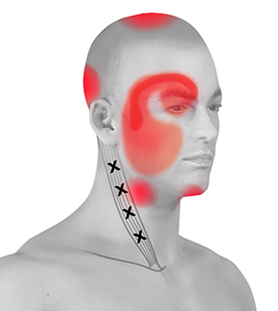Assessment and Management of Cervicogenic Headaches Post Traumatic Injury
Definition description[edit | edit source]
A cervicogenic headache (CGH) is a chronic headache that presents as unilateral pain starting at the neck and is perceived in one or more regions of the head/face (Khalili, et al., 2022) (see more about cervicogenic headaches here).
A common cause of CGH is trauma that has led to dysfunction of the neck. Types of trauma that can cause CGH most commonly include: whiplash caused by car accident, contact sport injuries causing concussion or neck injury, and falls leading to upper cervical structural damage (Page, 2011).
Mechanisms of injury caused by these types of trauma may include structural damage, development of myofascial pain and interaction of the trigeminal nociceptive system with the occipital nerves. There are also emotional and psychological factors to consider post-trauma which can impact rehabilitation and healing outcomes (Packard, 2002).
Epidemiology[edit | edit source]
Studies focused solely on CGH post trauma is limited. Current research states:
· Prevalent in 30 to 44 year-olds
· Accounts for 1-4% of headaches
· Equally prevalent between males and females
· Onset is said to be early 30s and diagnosis is 49.4 years-old (due to seeking medical attention late)
· Compared to other headache patients, CGH have pericranial muscle tenderness on the painful side (Khalili, et al., 2022)
Relevant anatomy[edit | edit source]
The cervical spine is made up of 7 vertebrae (C1 to C7), cranial nerves (C1 to C8), muscles and ligaments (see cervical anatomy)
Joints[edit | edit source]
· C1 (atlas) supports the skull and articulates superiorly with the occiput to form the atlanto-occipital joint. This allows for 33% of flexion and extension at the C-spine
· C2 (axis) articulates with the atlas to form the atlantoaxial joint. Its main function is to provide 60% of cervical rotation
· C3-C7 are similar to one another and make up the rest of the movement in the C-spine (Keiser, et al., 2021) (Singh, 2021)
Muscles innervated by C1-C3[edit | edit source]
· Rectus capitis and lateralis
· Longus capitis
· Prevertebral muscle
· Sternocleidomastoid
· Levator scapulae
· Upper trapezius
· Scalenus Medius (Keiser, et al., 2021)
(Sendić, 2022)
Ligaments (C1-C3)[edit | edit source]
· Apical
· Alar
· Cruciform
· Anterior/posterior longitudinal
· Ligamentum flavum
· Interspinous
· Nuchal
· Transverse (Keiser, et al., 2021)
(Fiester, et al., 2021)
Trigeminocervical nucleus[edit | edit source]
· Located at the upper cervical spinal cord
· Vertical cluster of cell bodies in the medullary region
· Sensory nerve fibbers in the descending tract of the trigeminal nerve are believed to interact with sensory fibres from the upper cervical roots
· Shares a common convergence with C1, C2, and C3 spinal nerve (Chua, et al., 2012)
(Mackenzie, 2017)
Etiology[edit | edit source]
A CGH is believed to be pain referring from dysfunction of cervical structures innervated by cervical nerves C1, C2 and C3. Meaning, trauma causing damage to joints, intervertebral discs, ligaments and muscles can all be a source of a CGH. There is limited evidence to suggest that the lower cervical spine plays a role in referred pain causing a CGH.
The most common cause of CGH have been attributed to whiplash injury. It is believed that this type of injury accounts for up to 53% of all CGH, with 15.2% of patients having a headache lasting longer 42 days and 4.6% developing chronic daily headaches (Ludvigsson, et al., 2019). Research also suggests that around 50% of CGH originate from the C2-C3 zygapophysial joint (Becker, 2010).
Pathophysiology[edit | edit source]
Activation of the trigeminal nerve and its connections are well established in regards to headaches. In terms of post-traumatic CGH, activation occurs from disruption of structures innervated by spinal nerves C1-C3.
· Efferent innervation converges onto the second order neuron at the dorsal horn of C1/C2
· At the same time, the trigeminal nerve will send sensory information from the face
· The trigeminal nerve converges in the second order neuron in the trigeminocervical nucleus at the same spinal segment as C1/C2
· When afferent nociception stimulus from the upper cervical structures travel to the trigeminocervical nucleus, the information sent to the somatosensory cortex becomes corrupt
· This is due to the higher number of nociceptive efferent nerves in the face compared to the upper cervical spine
· The convergence within the trigeminocervical nucleus means the brain will process this as an error, as it will assume the pain originates from the area with the higher area of nociceptive innervation
· As a result, pain originating from the upper C-spine will be referred to the head and present as a CGH
· Lower pain thresholds caused by emotional changes and aseptic inflammation can increase CGH pain levels further (Blumenfeld & Siavoshi, 2018)
(Physio Tutors, 2019)







